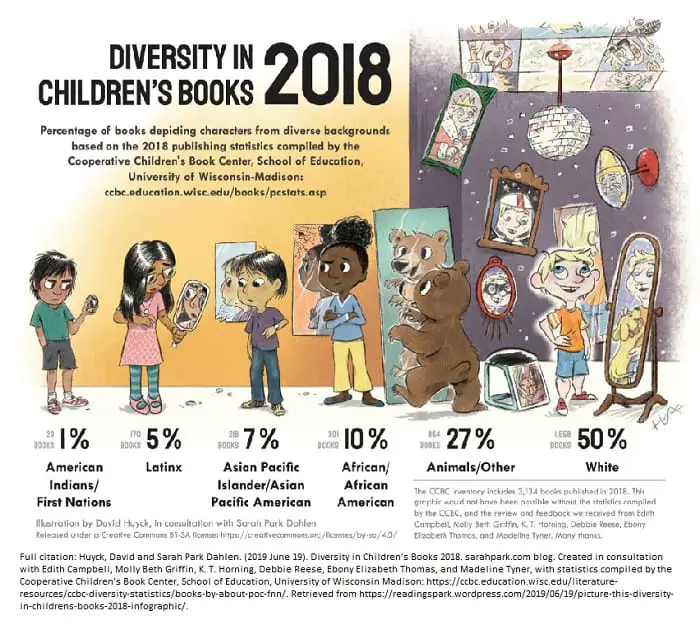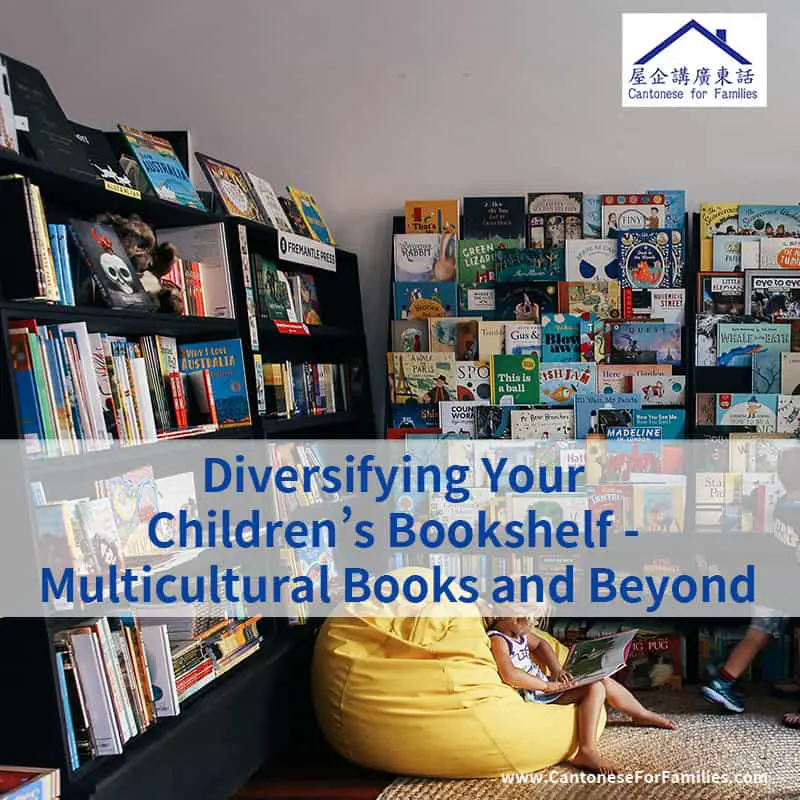This year will be the first time I am participating in the Multicultural Children’s Book Day (28th January), an initiative to raise awareness around kids’ books that celebrate diversity and also get more of these types of books into classrooms and libraries. I’ll be reviewing three multicultural books that have been assigned to me (alas, none in Cantonese!), and a few Cantonese books.
We have always made an effort to invest in toys and books that promote inclusivity – be it dolls of various skin tones, books with indigenous themes, multicultural characters, books by Australian-Asian authors, but I feel there is still much for me to learn, so I delved deeper into the topic of diversity and representation in children’s books.
About Multicultural Books
Let me try to summarize some key facts about diversity and representation in children’s books to aid you in your selection of children’s books for your kids.
- Lack of Diversity in books There is a shocking lack of diversity in children’s books, although it has been improving. The Diversity in Children’s Books 2018 infographic paints a dismal picture in the U.S. – half of the books reviewed feature white characters, whilst 27% depict animals and others non-human characters, which would be more than all the visible minorities combined at 23%. And this is actually an improvement from past years, according to these statistics by Cooperative Children’s Book Center (CCBC)

- Mirrors and Windows Diverse books should include ‘mirror’ books that allow children to see reflections of themselves, and ‘window’ books which help them to see other worlds. (This metaphor was coined by Emily Style and expanded by Rudine Sims Bishop , “Mother” of multicultural children’s literature. You can click on their names to read their original essays. ) When children see themselves (accurately portrayed) in books, it gives them a sense of belonging and identity, as well as self-worth. Books that teach you about the world, and about other people who are different from us, are also essential to help children to understand there is more than one way to see the world. This helps children to be more empathetic towards others, reducing unconscious bias and prejudices against those who are different from themselves. Imagine a world with less racism and prejudice!
- Diversity is not limited to ethnicity. Diversity and representation encompass gender, (dis)ability, religion, economic class, culture, family dynamics, settings and so on, and all these segments show similar underrepresentation as ethnicity.
- Accurate representation matters. Many books were, and still are, riddled with stereotypes, caricatures and negative portrayals. Slant eyes and yellow face were used to represent Asians. Chapter books talking about Chinese eating dogs. No surprise that when I was backpacking in Europe in my younger days, people asked me if I ate dogs. (I know they were genuinely curious and did not mean to offend, but still upsetting).
- Diverse Authors and #own voices Diverse authors have their own perspectives of the world, and this shows in their writing. #ownvoices refers to books about characters of diversity written by an author sharing the same identity. The writing is inspired by the author’s own experiences and written from their own perspective, hence reinforces the authenticity of their writing. This is not to say that diverse writing should be limited to diverse authors, or that diverse authors should be limited to writing about their experience. I plan to find more stories by diverse authors, and also specifically authors of Hong Kong heritage, regardless of if they are writing about Hong Kong, or about aliens.
- Selecting the right multicultural books. I strongly recommend this article Guide for Selecting Anti-Bias Children’s Books. While there is an increase in choices of diverse books, some may be harmful. It is not just who is depicted in the books. It is about how they are depicted that will make a difference to your child’s understanding of themselves, and of the world.
“Do your books reinforce or counteract messages that teach children to feel inferior or superior because of their skin color, gender, family income, able-bodiedness, or type of family structure?”
Hopefully the above information will help to motivate and guide you in choosing multicultural books for your children.
Beyond Multicultural Books – Other Ways to Increase Book Diversity on Your Child’s Bookshelf:
Many of the discussions about diversity in books that I have read centered on books published in US, in UK and in Australia (of course I only read English articles, so the results are likely skewed). Also these countries have diverse populations, hence the increasing awareness for the need for books to catch up.
International Books

One area of book diversity that I have not seen discussed in mainstream articles is that of international books. If you can access books from a different country (and written for a different audience), you can learn about how other countries view themselves and see the world through their eyes. International books often provide a window into a different culture, customs, another way of thinking and a different set of values.
Take for example the difference between Children’s Books In China And The U.S.. According to researchers, the books from different regions focus on different values. The Chinese books examined, places more emphasis on ‘ learning-related values ..including setting a goal to achieve something difficult, putting in a lot effort to complete the task and generally viewing intelligence as a trait that can be acquired through hard work rather than a quality that you’re born with’. Contrary to that, US books tend to focus more on ‘encouraging children’s happiness and sense of connection to others’.
This is why, whichever country we travel to, I take the opportunity to buy a book for myself and for my child, to open our minds to more diverse and international voices.
Books from your Heritage Culture/ Home Country
If you and your child grew up in a different country, choosing books from one’s heritage culture can also provide a deeper connection to it, and with a better understanding of differing values and understanding of different mindsets, and help them to navigate their identity. There is also a higher chance of seeing protagonists that resembles themselves or family members.
To this end, I have been buying books from Hong Kong, including books in Chinese, Cantonese and English. I especially love books where I can get a glimpse of life in Hong Kong, and I am so excited to share that with my child, especially now with the pandemic when it is still not convenient to travel there.
Books In Different Languages
Language and culture are inextricably connected. Culture shapes language, and language is a form of expression of culture.
For example, Chinese family/ kinship designations (e.g. 四舅母 is not just Aunt, but mother’s 4th oldest brother’s wife) reveal how hierarchical the Chinese family is, with your position in family determined by generation, age, and gender, as well as whether the relationship is by blood or marriage)
It has been hypothesized that the structure of the language you speak influences your worldview, your thoughts and beliefs, and even your decisions. Language can help you to express your ideas, or limit your expression. For those of you who speak other languages, how often have you struggled to translate a term into English?
Let me give some Chinese examples of difficult to translate phrases.
-
-
- 辛苦你了 (san1 fu2 nei5 laa1/ Xīnkǔ nǐle– A phrase that acknowledges the tremendous effort the other party has put in, together with a sense of gratitude and appreciation. It is more than a mere ‘Thank You Very Much’.
- 加油(gaa1 jau2/ Jiāyóu ) – “Add Oil” , a phrase so commonly used by Chinese that its English equivalent has made it to the Oxford dictionary.
-
You also have Chinee idioms that are rich in imagery and require a whole story to explain them. E.g. 畫蛇添足 (waak6 se4 tim1 zuk1 /huàshétiānzú) drawing feet on a snake – to overdo something and hence ruining it.
If you speak another language, especially a heritage language, I would highly recommend you consider getting more books in that language where possible, and reading them, or even translating them as you read to your child if he or she does not speak that same language.
If you and/ or your child does not cannot read/ speak another language, do not worry. There are other options for you to gain insights into another culture:
- Audio books for those who can speak but cannot read
- Living books – another term for actual people who can share their real-life experiences and life stories.
- Television shows and movies in a different language with English subtitles (I know this is not a book, and I believe in screentime in moderation, but hey, there is a lot to be learnt from them too)
- Translated books
- English books that integrate other languages within its narrative.
Books in Cantonese
As Cantonese is my mother tongue, I have also sought out books in Cantonese, both for myself and my child. Colloquial Cantonese books are on the rise, with Standard Chinese books being more mainstream. However, Cantonese books just convey that special something that speaks to me.
And then there are phrases that exist only in Cantonese, and is not conveyed in Chinese, Mandarin or any other language. Take the words 熱氣 yeet hay (jit6 hei3/ – jiāyóu) for example. This Cantonese phrase encapsulates a whole Chinese philosophy of yin and yang, the traditional Chinese method of categorizing food into ‘heaty and cooling’ categories and the traditional Chinese medicinal principle of how these food types might affect your energy level and constitution, and result in sickness, irritability, acne, etc etc. There is no simple translation or explanation into English, or other languages. There is no simple translation or explanation of 熱氣 yeet hay in English, or other languages. But a Cantonese speaker would understand these two words immediately. (Anybody want to write a book about this for the English audience to share this important cultural insight? )
Advocating for Cantonese Books
As you can see, Chinese books alone are insufficient to convey these nuances that the Cantonese. Yet there are not many Colloquial Cantonese books.
I have been buying Cantonese books as I have noticed that seeing more Cantonese books in print helps to validate the importance of the language to my child, so that she feels good when she speaks Cantonese, especially when she is surrounded by non-Cantonese speaking children in school. The books also teach her to appreciate the beauty of the language.
Just recently I was filling up a form on the Multicultural Children’s Body Day website asking me which language of books I was seeking. There were many language choices, but none for Cantonese, only for Chinese. I have also observed that Duolingo has language courses in Klingon (a constructed language for Star Trek aliens), but not Cantonese. These situations made me feel invisible – how much more the impact on children who do not see their language as ‘valid’ or important. Given that there are over 80 million native Cantonese speakers in the world, Cantonese certainly deserves more recognition than Klingon.
Just as we support diversity and representation in books, we need to ensure that the diversity extends to books in our own language.
One of my new year goals is to promote more Colloquial Cantonese books and resources, to support more Cantonese authors and publishers. In the push for diversity for books for our children to be able to see themselves reflected, we must not forget about the diversity of languages, where Written Cantonese (and even spoken Cantonese) is often pushed aside and marginalised. Having more Cantonese books normalises the language in print form, and when more people will be able to see their language reflected in print, and validate their language.
Here are some booklists for Colloquial Cantonese books:
- Forty New Cantonese Graded Readers – Perfect for Improving Cantonese
- Colloquial Cantonese Books for Kids Part 1 – Visual Dictionaries
- Colloquial Cantonese Books for Kids Part 2 – Storybooks 廣東話口語兒童書 (2) – 故事書
- Free Online Cantonese Literature
- Storybooks Canada: Free 40 Leveled Readers in Colloquial Cantonese with Audio
I will also be trying my best to feature more Cantonese books regularly on my blog, and I have created a new category on the website menu so that you can easily look for Cantonese books.
I hope you will join me in supporting the publication of Cantonese books, for our children, as well as for ourselves.
You might also enjoy reading:
- Diversifying Your Children’s Bookshelf – Multicultural Books and Beyond
- My Book Reviews for Multicultural Children’s Book Day
- How To Read To Your Child When Your Cantonese Is Not Fluent
- Where to Buy Traditional Chinese Kids Books
- Where to find free eBooks and e-Magazines in Traditional Chinese for Kids
- What You Need To Know About Cantonese: the Vernacular and the Formal
- Written Cantonese – For or Against?
- Why it is hard for many ABCs to pass on Cantonese?

